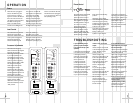
6
7
TROUBLESHOOTING
OPERATION
When the unit is plugged in
and (for the PB12 only) the
power switch is on and no
signal is received, the LEDs on
the front of the unit will turn
red. When a signal is present,
the LEDs will turn green.
Note: It will take several
minutes for the LEDs to turn
from green to red after the
input signal to the subwoofer
is removed. Due to JBL’s
unique, high-output,
high-
efficiency
amplifier design,
power consumption is minimal
when the subwoofer is not
receiving a signal. Of course,
the PB12 subwoofer can be
turned off, whenever desired.
The PB10 must be unplugged
if you do not wish to leave it in
auto (standby) mode.
The subwoofer Level Control
adjusts the volume of the
subwoofer relative to the rest
of the system. Proper level
adjustment depends on
several variables such as
room size, subwoofer
placement, type of main
speakers and listener position.
Adjust the subwoofer level so
that the volume of the bass
information is pleasing to you.
Crossover Adjustments
The Crossover Frequency
Control determines the highest
frequency at
which the
subwoofer reproduces
sounds.
If your main speakers can
comfortably reproduce some
low-frequency sounds, set this
control to a lower frequency
setting, between 50Hz – 100Hz.
This will concentrate the
subwoofer’s efforts on the
ultradeep bass sounds
required by today’s films and
music. If you are using smaller
bookshelf speakers that do not
extend to the lower bass
frequencies, set the low-pass
crossover control to a higher
setting, between 120Hz –
150Hz. This control is not used
when the LFE switch is in the
“LFE” position.
CROSSOVER
FREQUENCY
LEVEL
LINE LEVEL IN
PHASE
Min
Max
L
R
L R
For LFE use L or R
LFE NORMAL
PowerBass PB10
PowerBass PB10
HIGH
LEVEL
IN
L
R
HIGH
LEVEL
OUT
+ –
CAUTION
RISK OF ELECTRIC SHOCK
DO NOT OPEN
120V
60Hz, 160W
50Hz
0º 180º
150Hz
POWER
PowerBass PB12
CAUTION
RISK OF ELECTRIC SHOCK
DO NOT OPEN
120V
60Hz, 160W
ON OFF
CROSSOVER
FREQUENCY
LEVEL
LINE LEVEL IN
PHASE
Min
Max
L
R
L R
For LFE use L or R
LFE NORMAL
PowerBass PB12
HIGH
LEVEL
IN
L
R
HIGH
LEVEL
OUT
+ –
50Hz
0º 180º
150Hz
If you used the high-level
(speaker) inputs and there
is no sound from any of the
speakers:
•
Check that receiver/amplifier
is on and a source is playing.
• Check that powered
subwoofer is plugged into
an active electrical outlet
and is switched on.
• Check all wires and
connections between
receiver/amplifier and
speakers. Make sure all wires
are connected. Make sure
none of the speaker wires are
frayed, cut or punctured.
• Review proper operation
of your receiver/amplifier.
If there is low (or no) bass
output:
• Make sure the connections
to the left and right “Speaker
Inputs” have the correct
polarity (+ and –).
• Make sure that the
subwoofer is plugged into an
active electrical outlet and
(PB12 only) switched on.
• Adjust the crossover point.
• Flip the Phase Control
switch to the opposite
position.
• If you are using a Dolby
Digital/DTS receiver or
processor, make sure that the
subwoofer adjustments on
the receiver/processor are
set up correctly.
• Slowly turn the Level
Control clockwise until you
begin to hear the desired
amount of bass.
If you used the line-level
inputs and there is no sound
from the subwoofer:
•
Check that receiver/amplifier
is on and a source is playing.
• Check that powered
subwoofer is plugged into an
active electrical outlet and is
switched on.
• Check all wires and con-
nections between receiver/
amplifier and subwoofer.
Make sure all wires are
connected. Make sure none
of the wires are frayed, cut
or punctured.
• Review proper operation of
your receiver/amplifier.
• Slowly turn the Level
Control clockwise until you
begin to hear the desired
amount of bass.
• Make sure that you have
configured your receiver/
processor so that the
subwoofer/LFE output is on.
Phase Control
The Phase Control determines
whether the subwoofer’s
piston-like action moves in
and out in phase with the
main speakers or opposite
the main speakers. There is
no correct or incorrect
setting. Proper phase
adjustment depends on
several variables such as
subwoofer placement and
listener position. Adjust the
phase switch to maximize
bass output at the listening
position.
Remember, every system,
room and listener is different.
There are no right or wrong
settings; this switch offers the
added flexibility to adjust your
subwoofer for optimum
performance for your specific
listening conditions without
having to move your
speakers. If at some time
in the future you happen to
rearrange your listening room
and move your speakers, you
should experiment with the
phase switch in both
positions, and leave it in
the position that maximizes
bass performance.
Level Control
Power






